Photographing Dauin
Ok, so now I have been living and diving in Dauin since November, and what have I learned about underwater photography here? What would I tell a visiting photographer to look out for? Quite a few things! Firstly, the place is rightfully famous as a spot to find unusual, fascinating and rare small critters! On top of that the dark volcanic sand, makes for a very good photographic background, since its less likely to blow out images than white coral sand. You might actually have to increase your ISO value to achieve the same exposure as in a more typical white-sand area. The visibility in Dauin varies between a moderate 10 meters and lovely 30 meters, and the aforementioned sand settles fairly quickly; it is still, however, a very good idea to hover and not to lay on the sand, and to use a careful frog kick in order to not stir up the ground so much. As usual! The whole setting, with the superb macro and the dark volcanic sand is really quite similar to another famous macro site, the Liberty wreck In Tulamben, Bali. We don’t have a WWII wreck here, but the marine life is quite comparable.
So, where is Dauin? On the Philippine island of Negros:
What’s there to shoot? Charge your strobe batteries before you get started, because there is lots! I always think that knowing what to look for is a key ingredient in taking good photographs, and in picking the right lens for the job. Often there is a little trick for photographing each species, and these tricks I want to share now.
A family of fishes I particularly like are the ghost pipefish, the Solenostomidae. These are superbly fascinating apexes (api?) of vertebrate evolution! Seahorse-relatives which look like crinoids or algae, animals which have departed unusually far from the general fish body shape. Trippy fish! There are several species of these in Dauin, the harlequin ghost pipefish, the robust and the Halimeda one. These are rare in other places, but here we see so many of them that a dive without them is almost the exception. Last week I spotted five harlequin ghost pipefish together in a group around one crinoid. These are surprisingly hard to photograph with a macro lens, since they always turn and twist, so that there is always one part of the ghost pipefish out of focus. One option is to take a detail shot of the head or the beautiful tail only. For shots like that I had good success with my Canon 100 mm f2.8 macro lens (on a Canon 5DII camera). This lens generally is a great water buffalo (the Filipino equivalent to a workhorse) for macro photography in Dauin.
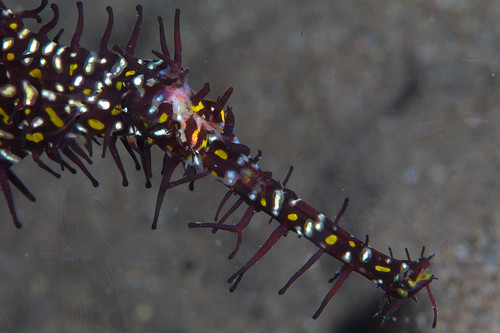
When trying to get shots of the whole ghost pipefish, or maybe even a couple of them together, I am using my Canon 50 mm compact macro lens. This lens allows me to capture a larger scene, and because it captures more light than the 100 mm lens I can use a larger f-stop. Hence I achieve a deeper depth of field, and one whole ghost pipefish, or even Mr. and Ms. ghost pipefish (the female is the larger animal) are in focus.
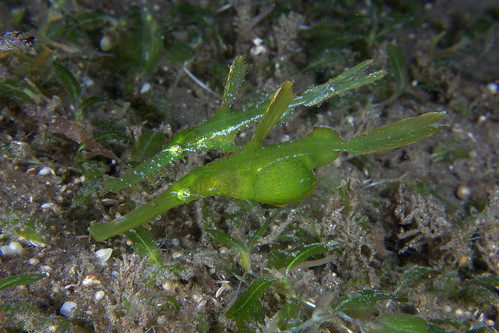
To go into the other direction, to even greater magnification, I am quite happy with my 1.25x extension ring. This ring adds 25% magnification to my 100 mm macro lens, at the price of not being able to focus at infinity anymore. But of course no one needs to focus on infinity when shooting macro! Such a super-macro setup is useful for shooting tiny wildlife like this pigmy pipehorse, Acentronura sp.:
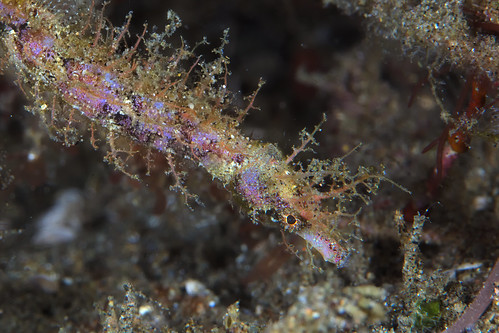
Besides ghost pipefish and pygmy pipehorses there are also “regular” seahorses abound, mostly Hippocampus histrix. These usually hide among the sponges in sandy regions, and on sunken pieces of wood. And, yes, we also have frogfish, although none as mighty as Battlecat. Still, Antennarius commersoni and A. pictus live in Dauin, and a few rarer species more. Right now a big burst of tiny A. pictus is living in the sand is seen.
The aforementioned crinoids are generally a good place to stop at and start scaning with your eyes. Between the tentacles and on the mouth disc lives a whole fauna of minute animals, shrimps, squat lobsters and clingfish. There are a few crinoid species which are typically well occupied, and others which barely ever have any residents. Once you dive with me, ask me to point out the shrimp positive crinoids.

You certainly didn’t think that I am forgetting about the bestest fishes ever, the gobies, in my photo guide to Dauin, didn’t you? There are fantastic gobies in Daui, tiny jewels of the ocean. A brilliantly colored small goby is Lubricogobius exiguus, which lives preferentially in disposed pieces of cloth or bottles at depths of more than 25 meters. These are exceptionally skittish fish, and only the slowest, calmest approach will get you within photo distance!

Dauin also has really nice shrimp gobies, at least ten species of them. I love watching the symbiosis between the watchman goby, and the digging shrimp constantly maintaining teh burrow used by both parnters. These are also rather nervous citizens of the ocean, and only a very careful approach will allow you to take a quality photograph of the pair. Shrimp gobies & shrimps might be good candidates for macro videography, with a camera placed in the sand in front of the shared burrow.
This leads us to the topic of shrimps …. for which Dauin is a top spot. A real shrimp watcher’s heaven. Sometimes you need to descend to go to heaven! Right now the sand in some dive sites is buzzing with skeleton shrimp, those tiny crustaceans looking like hectic match stick men.
There are also cleaner shrimp abound in Dauin, and most anemones have a few resident tiny translucent shrimps, often more than one species. Night dives are an excellent opportunity to shoot more shrimp and crab species, like the marble shrimp, decorator crabs, and several species of spider crabs.
Nudibranchs of course also crawl along their way too in Dauin. The dive sites with artificial reef structures are a good place to look for them. Once in a while you’ll see a shrimp hitching a ride on the body of a larger nudibranch. The fauna in that regard is pretty typical for the Philippines, with Chromodoris magnifica and Phyllidia pustulosa being the most common nudis.

At the end of the dive,on your way up from the dive to safety stop range at about 6 meters you’ll be able to observe and shoot sand divers – elongated fish which are named for their tendency to dive under the sand when they feel threatened. Sometimes the sand divers hover together in groups of tens just a few centimeters above the sand and feed on plankton; then the larger males spread their dorsal fins to show that they are the boss. At other times the sand divers rest on the sandy slopes, with their whole bodies exposed. A clumsy approach will make them disappear quickly into the sand, with sometimes the head still sticking out. All of these different modes of sand diver behavior are worth photographing! Look at the proportionally large eyes on this small fish, these are definitely visual animals.

I think wide-angle macro would be something working very well in Dauin. I don’t quite have the lenses and the gear for that kind of photography, but it would be a good approach to show some of the smaller marine animals in the context of their environment, for instance last week’s group of ghost pipe fish plus their home crinoid. Or, shooting a group of sand divers hovering together would also be a nice wide-angle macro shot.
All I have written about so far you can see within a 20 minute boat ride along the Dauin coast, under the towering volcanoes of Negros island. But there are also some really cool dive sites a bit further away, within day-trip distance from Dauin. These are Apo Island, Siquijur and Oslob, and these are all wide-angle kinda places.
Apo Island is one of the success stories of marine protection in the Philippines, with parts of it protected since the 70s. And it shows underwater, with a fantastic coral cover composed of many different species. Of course where there are corals there are coral fishes, and it’s especially the damselfishes which are present in large numbers and many species in Apo.
Apo also has many sea snakes, at least 3 species, which are fun to photograph. They are not exactly shy, but don’t hold still for a shot either. And to many marine turtles Apo is home as well. They seem like supremely chilled out animals, and sometimes take naps laying on the soft corals. The turtles of Apo are somewhat used to divers, and if you approach them from the side (not from above), not too quickly and not within less than a meter you will be rewarded with as much turtle watching time as you wish.

Siquijur, the island of black magic, about an hour by boat from Dauin offers fantastic walls and marine protected areas with a good population of larger fish such as gropers and parrot fish. The corals of Siquijiur are also quite impressive. I have only been to Siquijur twice, once for an advanced open water course, and once when the vis was quite bad, but this island has a lot of photographic potential.
Oslob, of course is the place with the whale sharks. These are big big fish. The biggest in existence on planet Earth right now, in fact. The whale sharks are fed to lure them to Oslob bay every morning, and this gives us underwater photographers the chance to come really close to these amazing fish. They are mostly near the water surface, and at that depth there is ample of sunlight in the Philippine summer for good ambient light shots even at 8 am. For the sake of the whale sharks which get photographed hundreds of times per day it’s not allowed to use flash photography in Oslob. On a flat day you can get the play of light from the ripples of the water surface onto the body of the whale shark in your shots, or you can capture a reflection of the animal on the ocean surface.
For photographing Rhincodon typus I mostly used my Tokina 10-17 mm fish eye zoom lens. This lens is originally meant for cropped sensor cameras, and to avoid the metal ring showing up on my shots I can only use it at the 17 mm end – that’s still a wide wide lens, though. I have also used the Canon 17-40 mm lens for the whale sharks, mostly at the 17 mm end as well. The visibility in Oslob can be mediocre, but when getting close enough with a really wide lens, then the viewers of your shots will not notice!
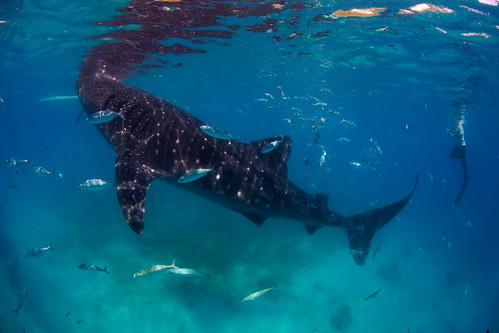





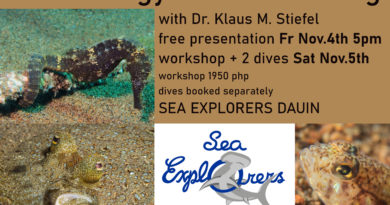
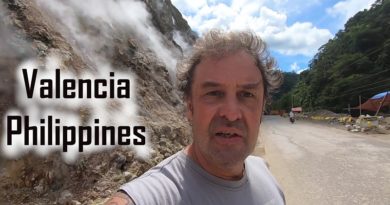
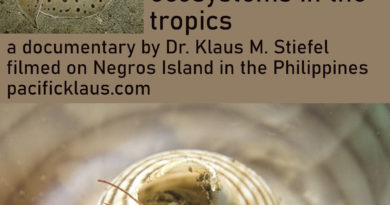
I was very good reading and lots of help what lenses to use 🙂